- Voters
- Am I in Danger of Having My Voter Registration Cancelled?
- Register to Vote
- Check voter status & find your polling place at TNSOS
- Polling Location and Complete District Information
- What to Expect When You Vote
- Voting Absentee
- Change of Address/Replacement Card
- Maps
- General FAQ about voting
- Restoration of Voting Rights
- Voter ID Requirements
- Accessibility
- Poll Workers
- Candidates
- Elections
- Outreach
- SCEC
- NEW! Overdue Campaign Finance Reports
- SCEC Agendas & Minutes
- Elected Officials
- Maintaining the Voter Registration Rolls
- The O.C. Pleasant Jr. Operations Center
- Life Cycle of an Election
- Access & Security Policy
- Public Records Requests
- Staff Bios
- Turnout
- Voter Registration Statistics & Reports
- History of the Shelby County Election Commission
- History of Shelby County Election Equipment
Life Cycle of an Election
Life Cycle of an Election
Step 1 – Certification of Candidates and Questions
Certification by the Shelby County Election Commission is required, for a candidate or issue, to appear on a ballot in Shelby County. To obtain certification candidates must file paperwork with the Shelby County Election Commission or the Secretary of State, depending on the office sought. Typically, this includes filing a petition with 25 signatures for local or state offices, along with the completion of campaign finance paperwork. Generally, issues to be decided by voters, come from a branch of government, like the City Council or County Commission. Some other issues that could be put on a ballot require a varying number of voters’ signatures, which may be a set number or percentage of registered voters.
Every signature submitted on petitions, for candidates or issues, is then verified against the Election Commission’s Voter Registration database. If the adequate number of required signatures is verified the petition is eligible for certification, put before the Election Commission, and the candidate or question will be placed on the ballot.
Step 2 – Estimating Voter Turnout and Allocating Equipment & Workers
Voter turnout from similar types of elections is reviewed and used to estimate the number of voters who will vote early as opposed to at each precinct on Election Day. For instance in some precincts, 70% of the voters will vote early. In other precincts, only 30% will vote early. Obviously, the precinct where early voting is less popular will have more voters on Election Day, so that precinct needs more machines and workers. Another factor that impacts the assignment of machines is the number of voters who will change their address on Election Day. These precincts need more workers because address changes take more of the poll workers’ time. The number of races and questions on the ballots also impact the number of machines required. On Election Day, 720 voting minutes are available per machine. If a ballot is exceptionally long or has a number of public questions, it might take a voter nearly five minutes to vote. At five minutes per voter, 144 people could vote on a machine on Election Day. If the ballot only takes a voter three minutes, 240 people could vote on the machine.
When all that information is collected and analyzed, estimates of the number of machines, poll books, and workers are developed. These estimates are reviewed after early voting has started. Sometimes a highly competitive race in one district will create more demand in that district, so the number of machines to be sent to that precinct for Election Day may need to be adjusted.
Step 3 - Programming
During this phase of election preparation, critical election information is entered into various software programs.
Information specific to each election, including the offices to appear of the ballot, the candidates running for those offices, and their district’s boundaries are programmed into the ballot creation software. Please Note: This software runs on an isolated computer that is never connected to the internet.
In a separate system, the eligible voters and their specific districts are identified. Voters who change their addresses or are registering for the first time are entered into the voter registration system. All voters must register by the deadline for the election.
During the final step, Election Day locations and the required number of workers for each are verified in the Poll Worker Management System.
Step 4 – Ballot Design & Proofing
Ballot design is the layout of the ballot content. The content of the ballot is dictated by federal and state law. State law specifically addresses the order in which races and candidates are arranged.
Because there are 166 precincts in Shelby County, there are a minimum of 166 different ballot faces for a general election. For a primary election, there are a minimum of 332 ballot faces. For an August County General and State/Federal Primary, there are at least 498 ballot faces. Since many Shelby County precincts are split by various districts, in some elections, there may be as many as 1000 ballot faces.
Each ballot face must be accurately proofed before ballot production can begin. Three different teams of people proofread each ballot face a minimum of three times to ensure accuracy.
Once the staff of the Shelby County Election Commission is satisfied that the ballots are error free, they are submitted to the Coordinator of Elections for approval.
In addition to the layout of paper ballots, used for overseas and absentee voting, electronic ballots must also be designed, produced, and proofed for use on electronic voting machines. Lastly, audio ballots must be recorded on electronic voting machines to allow the visual impaired voter to cast a private and secret ballot.
Step 5 – Equipment Testing
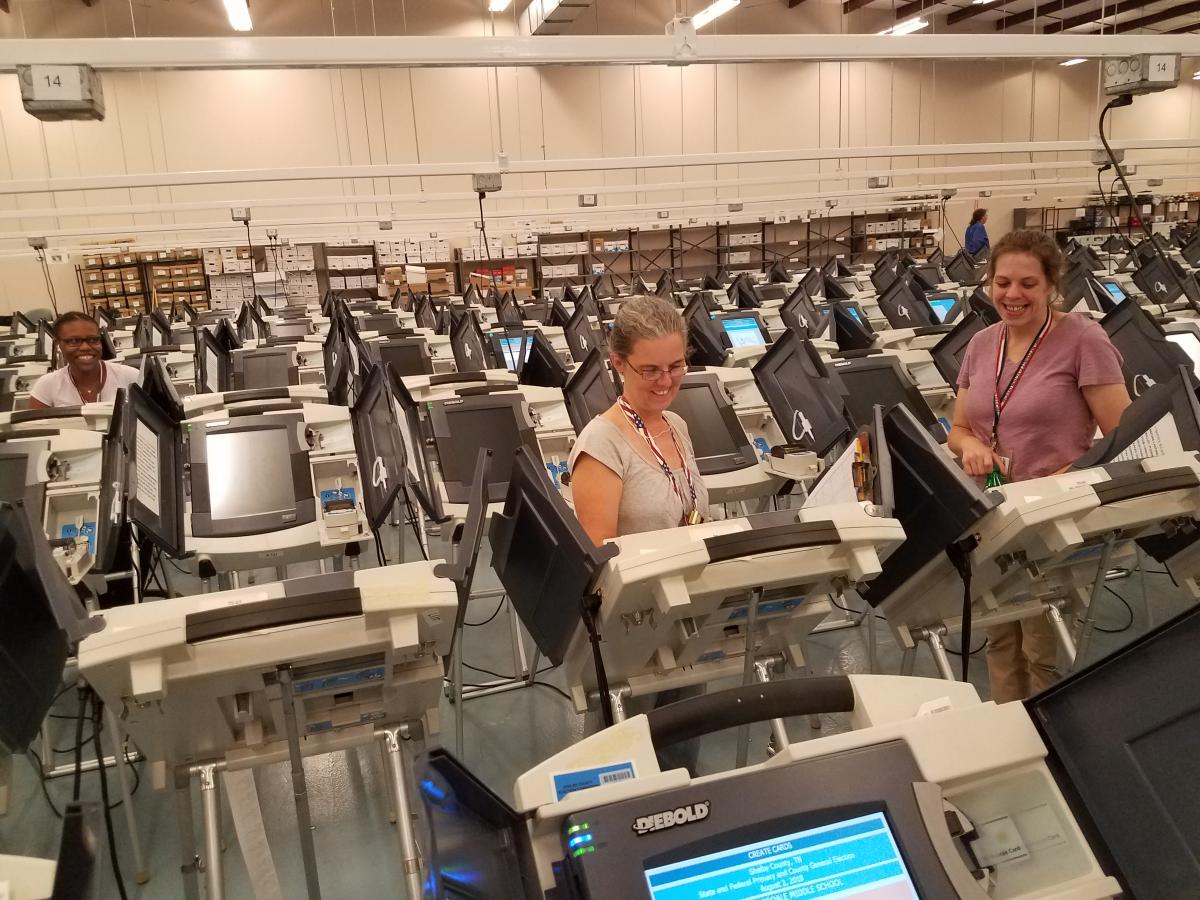 According to state law, prior to every election the equipment used to record, tabulate, and report votes must be tested. The testing by Shelby County Election Commission goes far beyond the state’s legal requirements. The first step in the process is to update the security keys, because they are changed for each election.
According to state law, prior to every election the equipment used to record, tabulate, and report votes must be tested. The testing by Shelby County Election Commission goes far beyond the state’s legal requirements. The first step in the process is to update the security keys, because they are changed for each election.
Then every piece of hardware is cleaned and tested. Machines are wiped down and the calibration is tested. The batteries are checked. The Electronic Pollbooks are tested, as well as the tabulation system.
Next Logic and Accuracy Testing begins. This is the process to make certain that voter choices are being accurately recorded and tabulated. It is performed by SCEC staff in bi-partisan teams. Test decks are then created, which includes at least one ballot of every type, and the sufficient numbers of ballots, so each candidate can receive a unique number of votes. We include at least one write-in vote for every race and include under- and over-voted ballots to make sure the equipment handles these special situations correctly. This test deck is tallied by hand. Then it used for test voting on an Early Voting machine. Finally, the test deck is scanned by the paper optical scanning machine. All three counts are compared and must match. The test deck is printed on pink ballot stock and each ballot is clearly stamped “Test Deck – Do Not Count,” eliminating the possibility that the test ballots could be Technicians verying that machines are programmed correctly. counted on Election Night.
Then every machine to be used at precinct on Election Day is tested to make certain the correct ballot styles come up on each machine and that they are recording and tallying votes correctly.
Once the machines are tested and a bi-partisan team has certified that there are zero votes on each machine, and that the correct ballots styles are on each machine, the machines are sealed. Each machine is tagged with the location is it to be sent to and chain of custody paperwork is prepared.
Step 6 - Ballot Production
Ballot production includes the printing of sample, provisional, and emergency ballots. A local printer prints the emergency and provisional ballots. There are very specific requirements for paper ballots – they must be a precise size and weight and must have a unique serial number stub that can be easily removed by election workers.
The Election Commission also prints paper ballots for voters who will be unable to vote in person and meet the requirements to vote by mail. These ballots are produced in the SCEC office. The SCEC owns two ballot-on-demand printers which prints the appropriate ballot needed for each voter.
Step 7 – Recruiting and Training Poll Workers
Shelby County may employ up to 1,600 people to work on Election Day. Poll workers are nominated by the political parties, but SCEC staff must verify the availability of workers, and arrange for their training. State law requires that every worker be trained for a minimum of three hours for each election. The scheduling takes 10 to 12 employees nearly two months to accomplish.
Step 8– Locking the Ballot Boxes
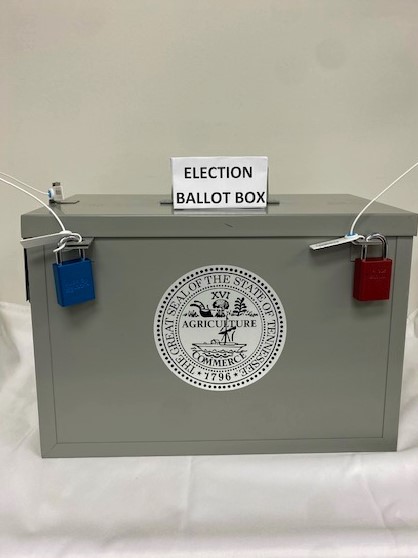 Every ballot box used in the election has two locks. An election commissioner from each party has the keys to one set of the locks. Boxes cannot be opened unless both parties are present.
Every ballot box used in the election has two locks. An election commissioner from each party has the keys to one set of the locks. Boxes cannot be opened unless both parties are present.
On the day the boxes are locked, the two commissioners in charge of locking the boxes meet at the Operations Center, where they will lock the boxes into which paper absentee ballots and provisional ballots will be inserted. They inspect each ballot box and verify that it is empty. The Republican Commissioner then places the Republican lock on the empty box and the Democratic Commissioner places the Democratic lock on the box.
Each Commissioner places a numbered seal on the locked boxes. A third numbered seal is placed which covers the ballot slot. All the seal numbers are recorded. At this point, the ballot boxes are ready to be delivered to the polls, and the absentee office and are ready for any mail-in and provisional ballots that might be cast. The Commissioners take their keys with them, ensuring that the boxes cannot be unlocked by anyone else.
The picture shows a fully locked ballot box.
Step 9 – Mailing Absentee Ballots
Once a request has been received from a voter who wish to vote by mail, staff makes the appropriate entries into the computer system and prints mailing labels. The ballot that corresponds with each voter’s home address is printed. An absentee packet, containing the ballot, an affidavit for the voter to sign, a secrecy envelope and a return envelope, is mailed to the voter through the United States Postal System. An Election Commission employee personally takes the absentee packet to the Post Office. The return envelope in the packet has a special barcode, (an Intelligent Mail Barcode) that will direct the Post Office mail sorting equipment to send the returned ballot directly to the Election Commission’s Post Office box. A post office box is used to guarantee that only USPS employees or our bi-partisan teams handle ballots, protecting the chain of custody.
Special laws apply to military voters and citizens who live outside the United States. These voters may have their ballots emailed to them, if they request it. Federal law requires that all military and overseas voters, who request a ballot on or before the 45th day before the election, must have their ballots mailed or emailed to them by the 45th day prior to the election.
Step 10 – Returning Absentee Ballots
Voted ballots may ONLY be returned by voters through the United States Postal Service or another commercial delivery service. To return a voted ballot by mail, the voter must affix the correct amount of postage if the ballot is being returned from a location in the U.S. Ballots from military and overseas voters may be returned without payment of postage.
All voted ballots must be received in the SCEC office by 7 p.m. on Election Day, in order to be counted. Voters are instructed to mail ballots to allow adequate time for the ballots to be received on Election Day. Ballots sent through the USPS should be mailed to: Shelby County Election Commission, PO Box 342798 Bartlett, TN 38184-2798. Ballots being returned by a commercial carrier should be sent to: Shelby County Election Commission, 980 Nixon Drive, Memphis, TN 38134 (phone 901-222-1200).
Tennessee law prohibits including ballots in the count which have not been returned by USPS or a commercial delivery service. Hand-delivered ballots cannot be accepted. A voter who has been mailed an absentee ballot cannot vote in person except by provisional ballot.
When our staff receives a voted ballot, the receipt of the ballot is noted in the computer system and is deposited into a secure ballot box. An audit is conducted daily and the number of ballots received must match the number of entries into the computer system.
Step 11 – Setting Up Polling Places
A few days before voting begins, a local moving company picks up the sealed machines and delivers them to the correct locations. Each location has a bill of lading that lists the machines and any other delivery items expected. Prior to transport, a representative from the moving company signs for the machines, and someone at the delivery location signs the bill of lading, verifying receipt of the machines. This paperwork is preserved so that the chain of custody of the machines can be identified. The moving company personnel also delivers any necessary tables and chairs, along with an American flag, if the polling place does not have one.
Step 12 – Early Voting
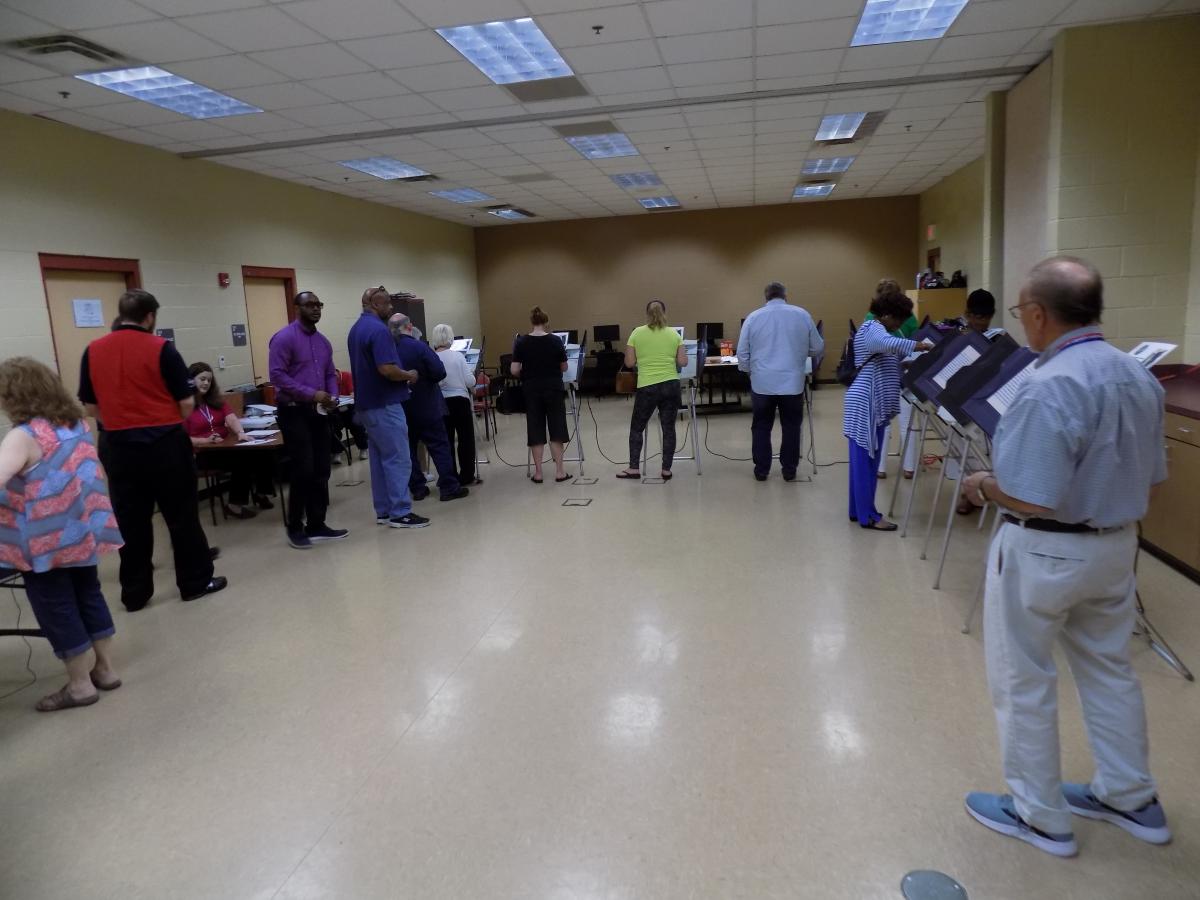 Starting the 20th day prior to each election, at least one Early Voting location opens. State law requires that an Early Voting be open in one of our two offices for the duration of Early Voting. Depending on the election, additional sites may open the first day, or a few days later. Early Voting takes place six days per week and most locations are open until 7 p.m. There is no Early Voting on Sundays or holidays.
Starting the 20th day prior to each election, at least one Early Voting location opens. State law requires that an Early Voting be open in one of our two offices for the duration of Early Voting. Depending on the election, additional sites may open the first day, or a few days later. Early Voting takes place six days per week and most locations are open until 7 p.m. There is no Early Voting on Sundays or holidays.
Any duly registered Shelby County voter may vote at any Early Voting location. During Early Voting name and address changes may be made.
Early Voting locations, dates, and hours of operation can be found at shelbyvote.com By law, Early Voting must end on the 5th day prior to the election unless the election is a presidential preference primary (PPP). In those elections, Early Voting ends seven days prior to Election Day.
Every day after Early Voting ends, election officials at each location lock and seal the machines. Seal numbers are recorded on a three-part form. One part of the form stays at the site, and the officer at the polling location takes home a copy. The third copy is taken home by a fellow poll worker who must be a member of the opposite political party. When the election officials return to the Early Voting sites the next day, they compare their copies of the custody forms to seals on the machines.
Meanwhile, back at the Operation center, staff reconciles the number of people who voted that day with the number of entries in the computer system and makes any changes, such as names or addresses, requested by the voter.
On the last day of Early Voting, a bi-partisan team waits with the machines until they are picked up. Chain of custody paperwork is completed and the machines used in Early Voting are returned to the warehouse where they are secured until tabulation on Election Day.
Step 13 – Preparing the Electronic Poll Books
Once Early Voting has ended, the list of voters who voted early or requested an absentee ballot is uploaded to the electronic poll books. This prevents a voter who voted early from voting again on Election Day. Depending on the size of the election, as many as 650 poll books must be programed and tested in the four days between the end of Early Voting and pick-up prior to Election Day.
Step 14 - Equipment Pickup
Election officers go the Operations Center the day before Election Day to pick up their supplies, including the ballot box, electronic poll books and provisional and emergency ballots.
Officers also receive a copy of the chain of custody paperwork so they, and a member of the opposite party, can confirm that the machines have not been tampered with when they arrive at the polling place the next morning.
Step 15 – Election Day at the Operations Center
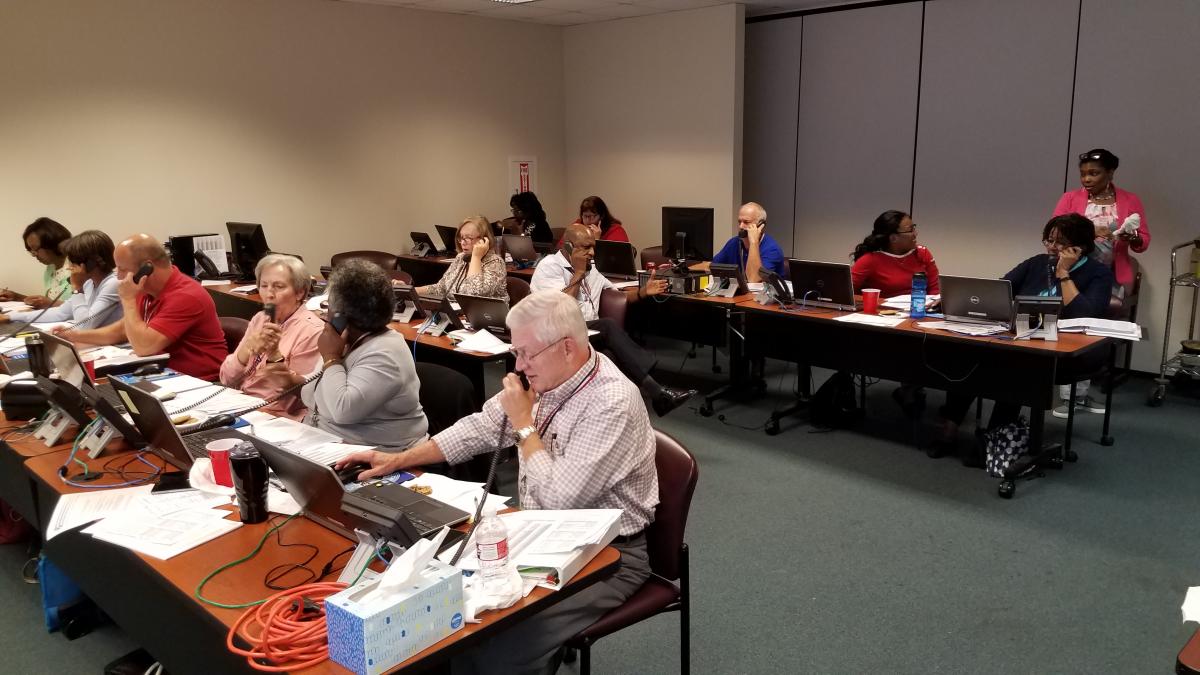 Our staff arrives at the Operations Center no later than 5:30 a.m. on Election Day. This includes regular staff and many temporary employees. There may be up to 25 additional workers staffing the help desk, 25 machine technicians, 8 provisional help desk workers and 16 absentee counting board members.
Our staff arrives at the Operations Center no later than 5:30 a.m. on Election Day. This includes regular staff and many temporary employees. There may be up to 25 additional workers staffing the help desk, 25 machine technicians, 8 provisional help desk workers and 16 absentee counting board members.
Six sheriff deputies assist with moving our technicians around the county, as quickly as possible, in case they are needed to check a machine’s calibration or address another technical issue. In addition to added employees at the Operations Center, 70 Inspectors are needed. They are responsible for supervising 2 or 3 assigned polling places, assisting poll workers if necessary.
Poll workers are scheduled to arrive at their designated polling places at 6 a.m.to be ready it for opening at 7 a.m. The first poll worker to arrive calls the Operations Center to report that setup work has begun inside the building. If a worker from every location have not checked in by 6:15 Help Desk Staff on Election Day a.m., the inspector for that location is notified.
At 7 a.m. Help Desk staff verify that all polls have opened on time. Throughout the day, these people answer questions from poll workers and voters.
Step 16 – Election Day at a Precinct Polling Place
Poll workers at each precinct setup and plug in the machines. (In case of a polling place power outage, machines have adequate battery life to operate until a generator arrives). Once the machines are set up, a bipartisan team checks to make sure all the seals match the chain of custody paperwork. Then they open each machine and run a zero tape. The team examines the zero tapes and signs them. The zero tapes are rolled up and locked in the printer compartment. Workers set up the electronic poll books, put out aids for visually and physically challenged voters, tape up the required signs, take an oath to be impartial and make sure an American flag is displayed.
During the day, poll workers check-in voters. Once a worker locates the voter’s correct name and address in the electronic poll book, a ballot application is printed and a voter access card is created. The voter access card has no personal information about the voter; it merely triggers the voting machine to bring up the correct ballot for that voter.
The voter takes the ballot application, and access card to the another table, where the voter gives the ballot application to the poll worker in charge of the voting machines. The voter signed the signature list and is directed to a machine. Almost always, the voter completes the ballot and the card is ejected. (For some unknown reason, in every election there seems to be at least one person who checks in but decides not to vote.) After the voter retrieves the ejected access card, the voter returns it and is offered an “I Voted” sticker.
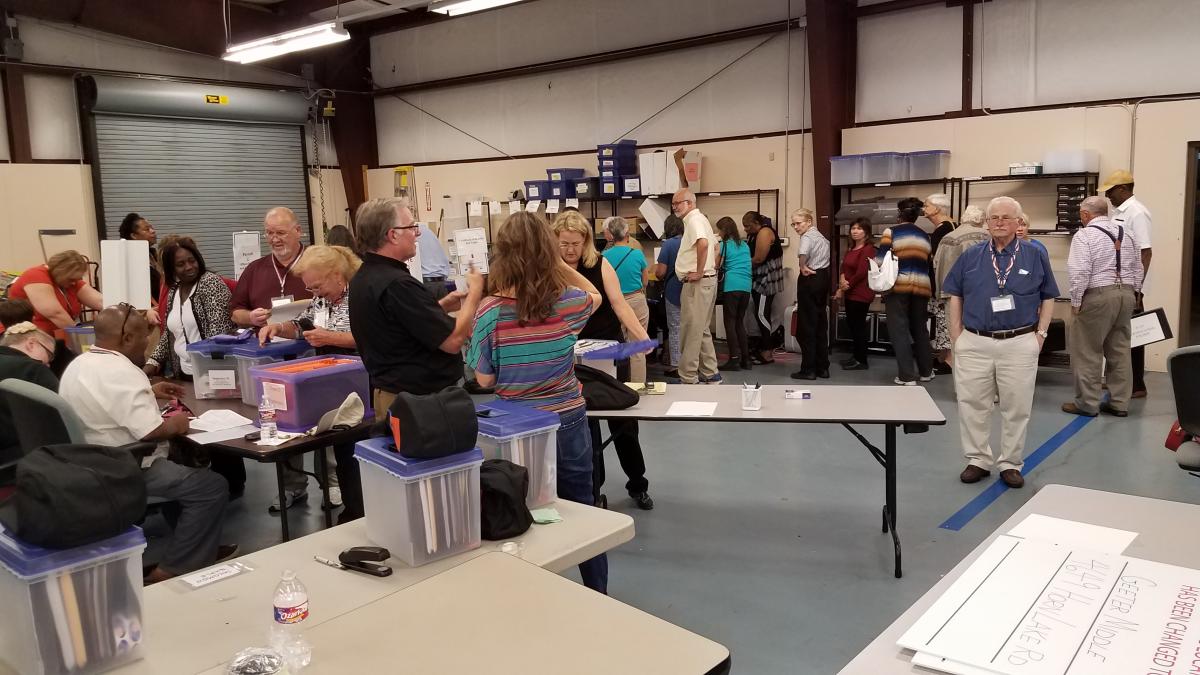
This continues throughout the day. When the polls close at 7 p.m., any voter who is in line is allowed to vote. When the last voter has finished voting, the officer reports to the operations center that voting at the polling location is finished; it is against the law for SCEC to release any early or absentee results until everyone has finished voting at every location.
When voting is finished, a bipartisan team closes down each machine and runs a results tape. Each tape is signed by each member of a bi-partisan team. Results are accumulated for that precinct – i.e. the results of every machine are combined to get a precinct total. A copy of that tape is posted for the public to see and photograph if they want. The officer and a member of the opposite party then take their memory devices, ballot boxes, and paperwork to the operations center.
Officers returning their materials after the election is over.
Step 17 – Counting Absentee Ballots
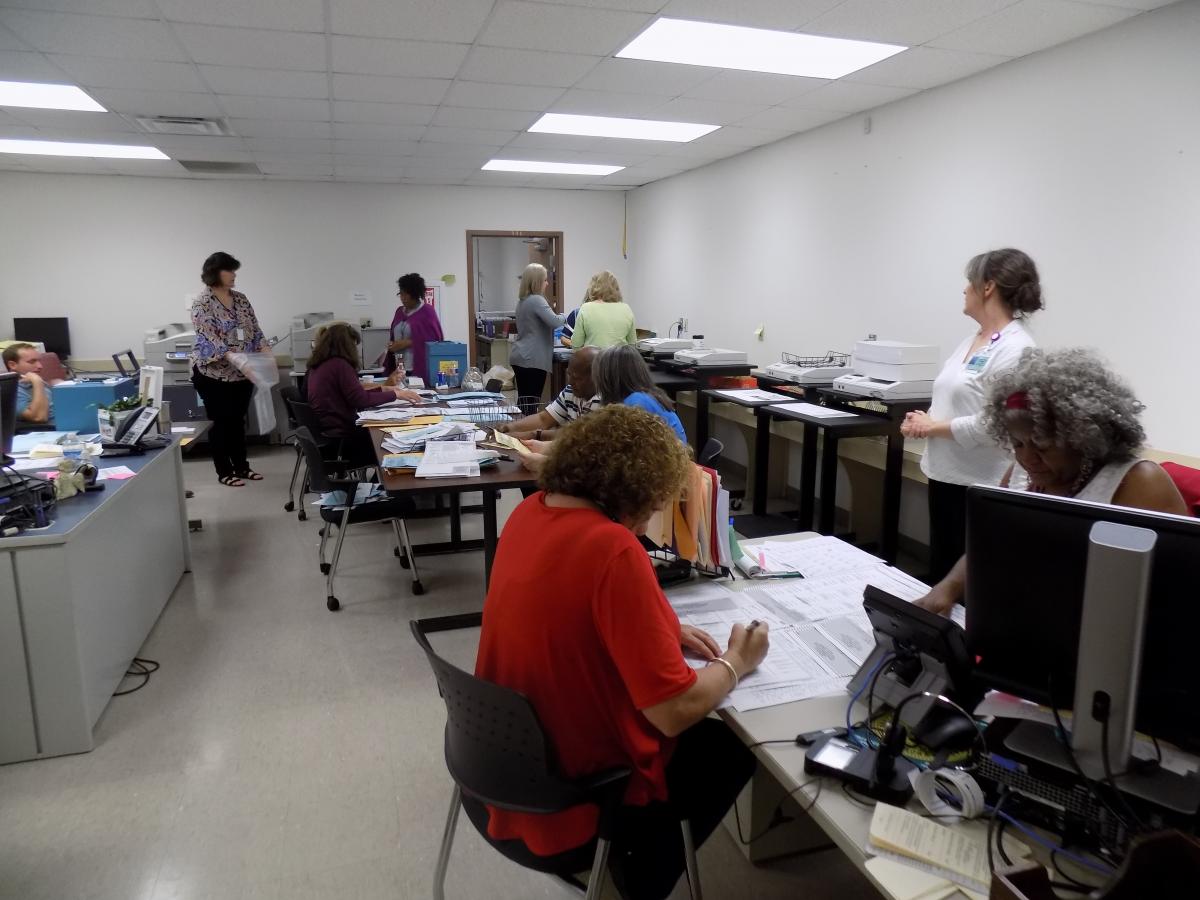 Absentee ballots are counted on Election Day. The first step in counting the paper absentee ballots is the unlocking of the boxes, which is done by the Commissioners with the designated keys. Depending on the number of absentee ballots, this process may start as early as 7 a.m. or as late as 5 p.m.
Absentee ballots are counted on Election Day. The first step in counting the paper absentee ballots is the unlocking of the boxes, which is done by the Commissioners with the designated keys. Depending on the number of absentee ballots, this process may start as early as 7 a.m. or as late as 5 p.m.
Once the ballot boxes are open, the Absentee Counting Board begins its work. Security is tight in the absentee counting area. People who wish to view the counting process may watch through a window but must surrender their cell phones until the ballots have all been tabulated; once people start watching, they may not leave until the Absentee Counting Board is finished.
The bi-partisan Counting Board starts by examining each affidavit. Tennessee law requires that the affidavit accompanying each ballot, is signed by the voter. If a signature is missing, or not that of the voter, the ballot cannot be counted. Those rejected ballots are placed in a box marked “Rejected.” If the Counting Board is satisfied that the signatures match, the affidavit is separated from the ballot envelope. If the accompanying affidavit is not signed, or if the signatures do not match, that ballot is rejected by the Board and that ballot is placed in a box marked “Rejected.”
Once affidavits have been removed from the secrecy envelopes, the team opens the envelopes, removes the ballot and flattens it to reduce the fold lines. The secrecy of the ballot is preserved because affidavits are removed prior to the opening of the ballot.
After the ballots are flattened, a bi-partisan team scans them through an optical scanner. When 50 ballots have been scanned, work pauses, and the stack, known as a “deck,” is weighed on a high-accuracy paper scale. If the scanner and the scale both verify that the deck count is 50, that deck is rubber banded together and placed in a ballot case. This work continues until all ballots have been scanned.
Once scanning is complete, a Deck Report is generated. The number of scanned ballots must match the number of ballots received, minus rejected ballots.
In the rare instance that a scanner cannot read a ballot, because it is damaged, one of the Counting Board’s bi-partisan teams examines the damaged ballot to determine the voter’s intent. In such cases, the bipartisan team marks a blank ballot. The original damaged ballot and the duplicate ballot are marked with the same number, for identification (if necessary). At the end of counting, the duplicate ballots are scanned, and the damaged ballots are sealed in a ballot box.
Often ballots are received from voters after 7 p.m. on election night. Those ballots are processed by Election Commission staff and marked, “Rejected-Received after 7 p.m. on Election Day.” They are not counted, and the voter is sent a letter explaining that SCEC received the ballot after the deadline.
Step 18 – Tabulating Early Voting Machines
On Election Day, a bi-partisan team verifies the seal numbers for each voting machine used in Early Voting against the paperwork prepared by the officer and deputy on the last day of early voting. The serial numbers and ballot count are also verified. The voting machines are opened and prepared for tabulation. No votes are tabulated until the last voter has finished voting.
Step 19 – Compiling Results
Precinct, Early Voting, and Absentee results are compiled on the ballot tabulation server, located in a room secured with key card locks. For security, the server room is monitored remotely by camera round the clock, every day of the year. No one is permitted to be alone in that room on Election Day; there is always a bipartisan team present.
The first step in the process is to run the Zero Reports. A bi-partisan team runs a Tabulation Report that shows that zero votes have been recorded prior to any ballot being tabulated. This report is signed by the Chairman and Secretary of the Election Commission.
Ballots are tabulated by collecting results from the early voting machines, paper ballot scanners, and precinct machines. The results from the machines are sent to the ballot tabulation computer through an isolated, secure network that has no ties to any other network or the internet.
Once the Early Voting results are compiled and the last voter has finished voting, a Results File from the ballot tabulation server is downloaded to a new flash drive. This never-used drive is virus free. The completed results file is then uploaded to a different computer, which is connected to the internet, so the results can be uploaded to our Election Night Reporting (ENR) software. All of this occurs inside the locked server room, which has a glass window, so the commissions and attorneys can view the process. Only key personnel are allowed in the area outside the server room. After the results are uploaded, the flash drive is destroyed immediately. This is done to eliminate the risk of transmitting a virus to the ballot tabulation server. Destruction guarantees that the flash drive is only used once.
On Election Night, unofficial election results are posted on the ENR software at ElectionsShelbyTN.gov and sent to the news media as soon as possible after the last voter has finished voting. Generally, early voting results are released around 7:15 p.m but might be later if there are lines at the polling places. Precinct results are updated as Precinct Reports are received. On average, the website is updated each time 30 more precinct results are received, until all 166 precincts have reported.
Step 20 - Provisional Ballots
A provisional ballot is used when a voter’s eligibility cannot be confirmed at the polling place, or if a voter fails to bring a government issued photo ID, required in Tennessee to vote. Another instance in which a provisional ballot would be used is if a voter believes registration occurred while getting a driver’s license, but the Election Commission has no record of it.
The voter completes paperwork at the polls and then votes on a paper ballot, which is sealed into a secrecy envelope and placed in a ballot box. The ballot boxes are delivered to the Operations Center after the polls close.
On Election Night, the Commissioners unlock the precinct ballot boxes. A bi-partisan team inventories the ballots by precinct, which are subsequently locked in the vault. The next morning, bi-partisan teams of staff begin the review of provisional paperwork using a detailed checklist and process. If evidence cannot be located that a voter was properly registered, then state agencies offering voter registration are contacted find out if their records indicate the voter registered. Bi-partisan teams then make a recommendation on each provisional ballot. Their recommendations are reviewed by supervisors.
Once supervisors have completed their review, the bi-partisan Provisional Counting Board meets. Its members determine which provisional ballots to accept. The accepted ballots are processed much like paper absentee ballots. The affidavits are removed from the secrecy envelopes. Once those are separated, the envelopes are opened, and the ballots are removed.
Provisional ballots are not machine readable and when they arrive at the Operations Center, they are sorted by precinct. For consistency, SCEC Election Commissioners have instructed staff to provide provisional ballots by precinct.
This means each ballot must be remade on a machine-readable precinct-specific ballot. A bi-partisan team remakes each ballot. These ballots are scanned in the same manner as paper absentee ballots.
Provisional ballots must by verified and counted within 4 days after the election, although that deadline can be extended by the Coordinator of Elections if there are a large number of provisional ballots.
Voters whose ballots were not counted because their voter registration status, are then registered to vote so they will be eligible in the next election. They are notified by a letter explaining why the provisional ballot did not count.
Step 21 – Post Election Reconciliation
After Election Day, various post-election activities occur prior to the official certification of results. These activities include processing provisional ballots, updating the addresses of voters who changed their address on Election Day, and posting election history to each voter’s record.
To begin the reconciliation process, Election Commission staff collects all forms that were used at the voting sites.
Addresses are changed and election history is updated in the voter registration system. The voter registration system is checked to make sure that all voters who voted had vote history correctly recorded.
After this work is completed, each precinct tape is reviewed. Tapes from the election machines are compared to the final tally to make sure that the votes are all properly counted.
Step 22 – Certification
No later than the third Monday after an Election, the Election Commission meets to certify the results.
The Commissioners review the paperwork and tallies. Once they vote to accept the results, those results are final unless a recount is ordered by a Judge. The official certified results are filed with the Secretary of State’s office, the County Clerk’s office and in the case of municipal elections, with officials at the municipalities.
Staff prepares a Certificates of Election for each of the winners. Those certificates are signed by members the Commission. The official results are posted to the website. The list of elected officials is updated and is placed on our website.
Finally, the required post-election reports are completed and filed with the Secretary of State. All the materials from the election are boxed up and labeled. Most election results are stored for 22 months, but the time is shorter for municipal elections – just 6 months. After the required holding period elapses, the materials are shredded and recycled.
